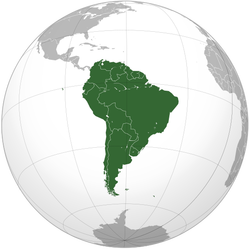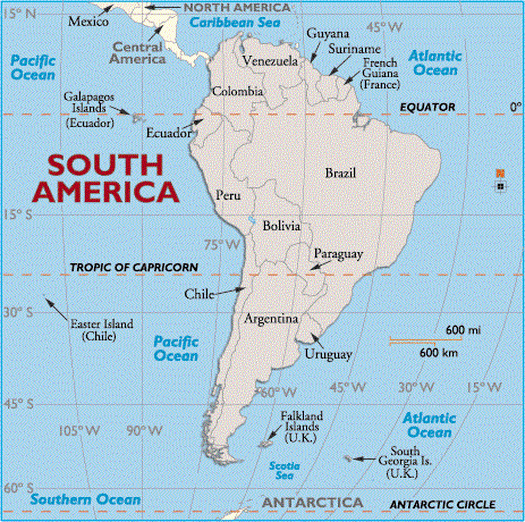South America
|
South America (Spanish: América del Sur or Sudamérica; Portuguese: América do Sul) is the southern continent of America,situated entirely in the Western Hemisphere and mostly in the Southern Hemisphere, with a relatively small portion in the Northern Hemisphere. It is bordered on the west by the Pacific Ocean and on the north and east by the Atlantic Ocean; North America and the Caribbean Sea lie to the northwest.
America was named in 1507 by cartographers Martin Waldseemüller and Matthias Ringmann after Amerigo Vespucci, who was the first European to suggest that the newly discovered lands were not India, but a New World unknown to Europeans.
South America has an area of 17,840,000 square kilometers (6,890,000 sq mi), or almost 3.5% of the Earth's surface. As of 2005, its population was estimated at more than 371,090,000. South America ranks fourth in area (after Asia, Africa, and North America) and fifth in population (after Asia, Africa, Europe, and North America).
America was named in 1507 by cartographers Martin Waldseemüller and Matthias Ringmann after Amerigo Vespucci, who was the first European to suggest that the newly discovered lands were not India, but a New World unknown to Europeans.
South America has an area of 17,840,000 square kilometers (6,890,000 sq mi), or almost 3.5% of the Earth's surface. As of 2005, its population was estimated at more than 371,090,000. South America ranks fourth in area (after Asia, Africa, and North America) and fifth in population (after Asia, Africa, Europe, and North America).
Geography of South America
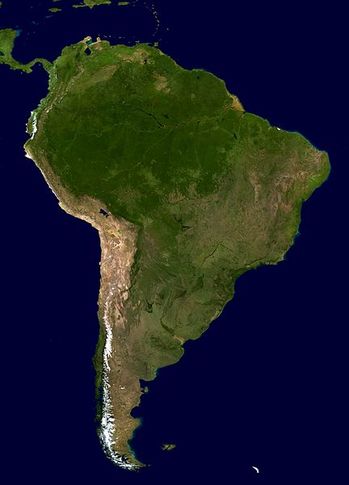
South America occupies the southern portion of the landmass referred to as the New World. The continent is generally delimited on the northwest by the Darién watershed along the Colombia–Panama border, or According to some sources by the Panama Canal which transects the Isthmus of Panama. Geopolitically and geographically all of Panama including the segment east of the Panama Canal in the isthmus is typically included in North America alone and among the countries of Central America.Almost all of mainland South America sits on the South American Plate.
Traditionally South America also includes some nearby islands. Aruba, Bonaire, Curaçao, Trinidad, Tobago, and the federal dependencies of Venezuela sit on the northerly South American continental shelf and are considered part of the continent.
Geopolitically, the island states and overseas territories of the Caribbean are generally grouped as a part or subregion of North America, since they are more distant on the Caribbean Plate, even though San Andreas and Providencia are politically part of Columbia and Aves Island is controlled by Venezuela.Other islands that are included with South America are the Galápagos islands that belong to Ecuador and Easter Island (In Oceania but belongs to Chile), Robinson Crusoe Island, Chiloé are also Chilean islands, while Tierra del Fuego is split between that country and Argentina. In the Atlantic Brazil owns Fernando de Noronha, Trindade and Martim Vaz, and the Saint Peter and Saint Paul Archipelago.
South America is home to the world's highest waterfall, Angel Falls in Venezuela; the largest river (By volume), the Amazon River; the longest mountain range, the Andes (Whose highest mountain is Aconcagua at 6,962 m [22,841 ft]); the driest place on earth, the Atacama Desert;the largest rainforest, the Amazon Rainforest; the highest capital city, La Paz, Bolivia; the highest commercially navigable lake in the world, Lake Titicaca; and, excluding research stations in Antarctica, the world's southernmost permanently inhabited community, Puerto Toro, Chile.
Traditionally South America also includes some nearby islands. Aruba, Bonaire, Curaçao, Trinidad, Tobago, and the federal dependencies of Venezuela sit on the northerly South American continental shelf and are considered part of the continent.
Geopolitically, the island states and overseas territories of the Caribbean are generally grouped as a part or subregion of North America, since they are more distant on the Caribbean Plate, even though San Andreas and Providencia are politically part of Columbia and Aves Island is controlled by Venezuela.Other islands that are included with South America are the Galápagos islands that belong to Ecuador and Easter Island (In Oceania but belongs to Chile), Robinson Crusoe Island, Chiloé are also Chilean islands, while Tierra del Fuego is split between that country and Argentina. In the Atlantic Brazil owns Fernando de Noronha, Trindade and Martim Vaz, and the Saint Peter and Saint Paul Archipelago.
South America is home to the world's highest waterfall, Angel Falls in Venezuela; the largest river (By volume), the Amazon River; the longest mountain range, the Andes (Whose highest mountain is Aconcagua at 6,962 m [22,841 ft]); the driest place on earth, the Atacama Desert;the largest rainforest, the Amazon Rainforest; the highest capital city, La Paz, Bolivia; the highest commercially navigable lake in the world, Lake Titicaca; and, excluding research stations in Antarctica, the world's southernmost permanently inhabited community, Puerto Toro, Chile.
Climate of South America

The climate of South America can be broadly divided into seven different climate types:
- Desert - Warm to high temperatures with very little rainfall.
- Grassland - Hot summers and cold winters with above average rainfall.
- Deciduous forest - Four distinct seasons with warm summers and cold, wet winters. The trees shed their leaves in autumn.
- Rainforest - High temperatures and high rainfall throughout the year.
- Savanna - This region has very high temperatures all year and rain during the summer season only.
- Mediterranean - Warm to high temperatures with rainfall in the autumn and winter months.
- Alpine/mountain - Cold, windy and snowy. It is winter from October to May with temperatures below freezing, while summer is from June to September where the temperature can reach 15°C.
History of South America
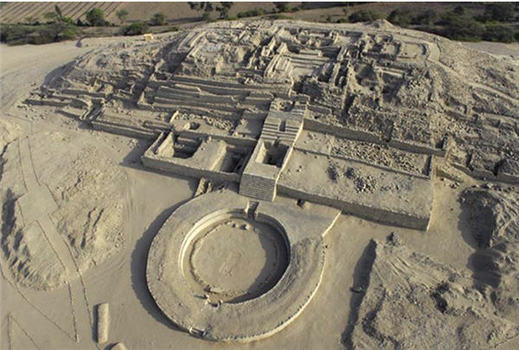
Norte Chico or Caral is the oldest known civilization in South America (Plus Americas)
By the first millennium, South America’s vast rainforests, mountains, plains, and coasts were the home of tens of millions of people. Some groups formed permanent settlements. Among those groups were the Chibchas (or "Muiscas" or "Muyscas"), Valdivia and the Tairona. The Chibchas of Colombia, Valdivia of Ecuador, the Quechuas of Peru, and the Aymara of Bolivia were the four most important sedentary Amerindian groups in South America.
The theory of pre-Columbian contact across the South Pacific Ocean between South America and Polynesia has received support from several lines of evidence, although solid confirmation remains elusive. A diffusion by human agents has been put forward to explain the pre-Columbian presence in Oceania of several cultivated plant species native to South America, such as the bottle gourd (Lagenaria siceraria) or sweet potato (Ipomoea batatas). Direct archaeological evidence for such pre-Columbian contacts and transport has been lacking, however. A 2007 paper published in PNAS put forward DNA and archaeological evidence that domesticated chickens had been introduced into South America via Polynesia by late pre-Columbian times.These findings were challenged by a later study published in the same journal, that cast doubt on the dating calibration used and presented alternative mtDNA analyses that disagreed with a Polynesian genetic origin.The origin and dating remains an open issue. Whether or not early Polynesian-American exchanges occurred, there are no discernible human-genetic, archaeological, cultural or linguistic legacies of that contact.
On the north-central coast of present-day Peru, Norte Chico or Caral (As known in Peru) was a civilizaton that emerged around 3000 BCE (Contemporary with urbanism's rise in Mesopotamia.) It is considered one of the six places where civilization has arisen independently in the world. It had a cluster of large-scale urban settlements of which the Sacred City of Caral, in the Supe valley, is one of the largest and best studied sites. Norte Chico or Caral is the oldest known civilization in the Americas (Plus South America) and persisted until around 1800 BCE.
South America has a history that spans the full range of human cultural and civilizational forms. While millennia of independent development were interrupted by the Spanish and Portuguese colonization drive of the late 15th century and the demographic collapse that followed, the continent's mestizo and indigenous cultures remain quite distinct from those of their colonizers. Through the trans-Atlantic slave trade, South America (Especially Brazil) became the home of millions of people in the African diaspora. The mixing of races led to new social structures. The tensions between colonial countries in Europe, indigenous peoples and escaped slaves shaped South America from the 16th through the 19th Centuries. With the revolution for independence from Spanish crown during the 19th century, South America underwent another social and political change that lasted until the early 1900s.
The theory of pre-Columbian contact across the South Pacific Ocean between South America and Polynesia has received support from several lines of evidence, although solid confirmation remains elusive. A diffusion by human agents has been put forward to explain the pre-Columbian presence in Oceania of several cultivated plant species native to South America, such as the bottle gourd (Lagenaria siceraria) or sweet potato (Ipomoea batatas). Direct archaeological evidence for such pre-Columbian contacts and transport has been lacking, however. A 2007 paper published in PNAS put forward DNA and archaeological evidence that domesticated chickens had been introduced into South America via Polynesia by late pre-Columbian times.These findings were challenged by a later study published in the same journal, that cast doubt on the dating calibration used and presented alternative mtDNA analyses that disagreed with a Polynesian genetic origin.The origin and dating remains an open issue. Whether or not early Polynesian-American exchanges occurred, there are no discernible human-genetic, archaeological, cultural or linguistic legacies of that contact.
On the north-central coast of present-day Peru, Norte Chico or Caral (As known in Peru) was a civilizaton that emerged around 3000 BCE (Contemporary with urbanism's rise in Mesopotamia.) It is considered one of the six places where civilization has arisen independently in the world. It had a cluster of large-scale urban settlements of which the Sacred City of Caral, in the Supe valley, is one of the largest and best studied sites. Norte Chico or Caral is the oldest known civilization in the Americas (Plus South America) and persisted until around 1800 BCE.
South America has a history that spans the full range of human cultural and civilizational forms. While millennia of independent development were interrupted by the Spanish and Portuguese colonization drive of the late 15th century and the demographic collapse that followed, the continent's mestizo and indigenous cultures remain quite distinct from those of their colonizers. Through the trans-Atlantic slave trade, South America (Especially Brazil) became the home of millions of people in the African diaspora. The mixing of races led to new social structures. The tensions between colonial countries in Europe, indigenous peoples and escaped slaves shaped South America from the 16th through the 19th Centuries. With the revolution for independence from Spanish crown during the 19th century, South America underwent another social and political change that lasted until the early 1900s.
Sovereign states and dependent territories in South America
|
|
Religion in South America

The Basilica of the National Shrine of Our Lady of Aparecida - second largest in the world, after only Saint Peter
South America is unusual among the continents for its religious homogeneity. About 90 percent of the population is Roman Catholic. Most of the Protestants are in Brazil and Chile; the remainder are widely distributed, primarily in urban centers.The Roman Catholic faith was brought to the continent by the Spaniards and Portuguese during the Spanish conquest. Protestantism is a reflection of later European immigration and of missionary activity begun in the 19th century. North American evangelical groups were particularly active in the 20th century.
Hindus, Muslims, and Buddhists are concentrated in Guyana and Suriname.
According to the most recent census, the Muslim population of Suriname represents about 13.5 percent of the country's total population (2004), giving the country the highest percentages of Muslims on the American continent.Muslims first came to Suriname as slaves from Africa. The next group of Muslims to come to the country consisted of indentured laborers from South Asia and Indonesia, from whom today most Muslims in Suriname are descended.
The Jews of South America also tend to be urban dwellers and are widely distributed; about three-fourths are in Argentina and Brazil, and more than 10 percent are in Uruguay and Chile.
Hindus, Muslims, and Buddhists are concentrated in Guyana and Suriname.
According to the most recent census, the Muslim population of Suriname represents about 13.5 percent of the country's total population (2004), giving the country the highest percentages of Muslims on the American continent.Muslims first came to Suriname as slaves from Africa. The next group of Muslims to come to the country consisted of indentured laborers from South Asia and Indonesia, from whom today most Muslims in Suriname are descended.
The Jews of South America also tend to be urban dwellers and are widely distributed; about three-fourths are in Argentina and Brazil, and more than 10 percent are in Uruguay and Chile.
Economy of South America
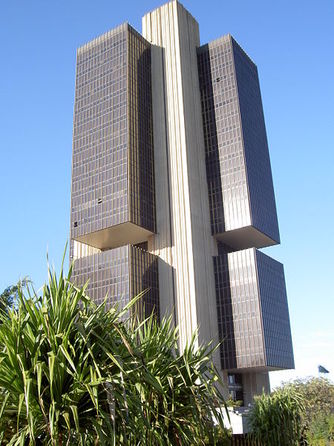
Central Bank of Brazil
During the last two decades, South American countries have experienced significant economic growth, which can be seen in many of these countries with the construction of new skyscrapers like the Gran Costanera tower in Chile, and also transportations systems like the Bogota Metro. However, because of histories of high inflation in nearly all South American countries, interest rates remain high and investment remains low. Interest rates are usually twice that of the United States. For example, interest-rates are about 22% in Venezuela and 23% in Suriname. The exception is Chile, which has been implementing free market economic policies since establishing military dictatorship in 1973 and has been increasing its social spending since the return of democratic rule in the early 1990s. This has led to economic stability and interest rates in the low single digits.
South America relies heavily on the exporting of goods and natural resources. On an exchange rate basis Brazil (The seventh largest economy in the world and the largest in South America) leads the way in total amount of exports at $137.8 billion dollars followed by Chile at 58.12 billion and Argentina with 46.46 billion.[2009]
The economic gap between the rich and poor in most South American nations is considered to be larger than in most other continents. In Venezuela, Paraguay, Bolivia and many other South American countries, the richest 20% may own over 60% of the nation's wealth, while the poorest 20% may own less than 5%. This wide gap can be seen in many large South American cities where makeshift shacks and slums lie adjacent to skyscrapers and upper-class luxury apartments.
South America relies heavily on the exporting of goods and natural resources. On an exchange rate basis Brazil (The seventh largest economy in the world and the largest in South America) leads the way in total amount of exports at $137.8 billion dollars followed by Chile at 58.12 billion and Argentina with 46.46 billion.[2009]
The economic gap between the rich and poor in most South American nations is considered to be larger than in most other continents. In Venezuela, Paraguay, Bolivia and many other South American countries, the richest 20% may own over 60% of the nation's wealth, while the poorest 20% may own less than 5%. This wide gap can be seen in many large South American cities where makeshift shacks and slums lie adjacent to skyscrapers and upper-class luxury apartments.

